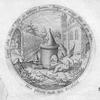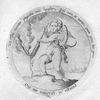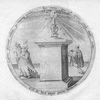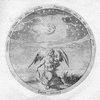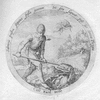A autruy mort, a moy vie [6]
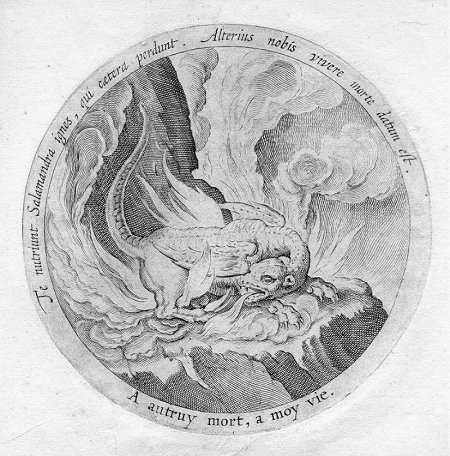
In’t vier leef1
ick altijdt/ tot ’t vier ben
ick gheboren
Het is mijn lust mijn vreucht/ het vier hebb’ ick ghecoren2/
Daer zonder can ick niet/ O had ick niet het vier/
Het vier dat my verheucht/ ick waer een schamel3 dier.
O vier blijft my maer by/ en wilt my niet begheven/
Het gheen dat ander quetst is oorsaeck van mijn leven.
Het vier is mijn behoudt/ het gheen dat ander schaedt
Is oorsaeck dat ick ben bevrijdt van alle quaedt.
Het is mijn lust mijn vreucht/ het vier hebb’ ick ghecoren2/
Daer zonder can ick niet/ O had ick niet het vier/
Het vier dat my verheucht/ ick waer een schamel3 dier.
O vier blijft my maer by/ en wilt my niet begheven/
Het gheen dat ander quetst is oorsaeck van mijn leven.
Het vier is mijn behoudt/ het gheen dat ander schaedt
Is oorsaeck dat ick ben bevrijdt van alle quaedt.

Translations
 |
Voor een ander de dood, voor mij het leven. |
 |
Death to the one is life to the other. |
 |
Salamander, het vuur dat andere dieren doodt, voedt jou. Zo kunnen wij door andermans dood leven. |
 |
Salamander, the fire that kills other animals feeds you. Thus the other’ death is life to us. |
Literature
-
Henkel and Schöne, Emblemata
 , col. 740
, col. 740
-
Praz, Seventeenth-Century Imagery
 , pp. 85,92
, pp. 85,92
Sources and parallels
- Same emblem in 1601 edition: A autruy mort, a moy vie [6] (in: Daniël Heinsius, Quaeris quid sit Amor (c. 1601))
[Compare
![Compare [compare]](/static/images/compare2.gif) ]
]
- Source for the metaphor of the lover as a salamander in the fire: Petrarca, Canzoniere
 , poem. 207
, poem. 207
- Source for the pictura: Paradin, Princeliicke Deviisen
 , embl. 8
, embl. 8 - Source for the emblem: Valeriano, Hieroglyphica
 , pp. 162-164
, pp. 162-164 - A probable source for the pictura: Giovio, Dialogo dell'imprese
 , pp. 28-29
, pp. 28-29 - A parallel (and probably adaptation) for the motto, pictura and entire
emblem: Mea vita per ignem [115] (in: Otto Vaenius, Amorum emblemata (1608))
[Compare
![Compare [compare]](/static/images/compare2.gif) ]
]
-
Parallel in the 1616 edition: motto the same, subscriptio departs slightly, pictura is partly mirrored: A autruy mort, a moy vie. [30] (in: Daniël Heinsius, Ambacht van Cupido, from: Nederduytsche poemata (1616))
[Compare
![Compare [compare]](/static/images/compare2.gif) ]
]
-
A parallel for the French motto and the pictura (though mirrored salamander and addition of Cupid).Une Salamandre au feu (in: Daniel de la Feuille, Devises et emblemes (1691))
[Compare
![Compare [compare]](/static/images/compare2.gif) ]
]
References, across this site, to this page:
- Une Salamandre au feu (in: Daniel de la Feuille, Devises et emblemes (1691))
- A autruy mort, a moy vie [6] (in: Daniël Heinsius, Quaeris quid sit Amor (c. 1601))
- A autruy mort, a moy vie. [30] (in: Daniël Heinsius, Ambacht van Cupido (1613))
- A autruy mort, a moy vie. [30] (in: Daniël Heinsius, Ambacht van Cupido, from: Nederduytsche poemata (1616))
- Mea vita per ignem [115] (in: Otto Vaenius, Amorum emblemata (1608))
Iconclass
A salamander lying in a fire- fire (one of the four elements)
[21C]

- salamander (fabulous animal); salamander as spirit of fire
[25FF412]

- rocks
[25H112]

- open fire (in general)
[41B1]

- (personifications and symbolic representations of) Love; 'Amore (secondo Seneca)' (Ripa) (+ emblematical representation of
concept)
[56F2(+4)]

- Vitality, Viability, Vital Force (+ emblematical representation of concept)
[58B1(+4)]

- proverbs, sayings, etc. (with TEXT)
[86(A AUTRUY MORT, A MOY VIE)]

![[H O M E : Emblem Project Utrecht]](/static/images/rd-small.gif)




